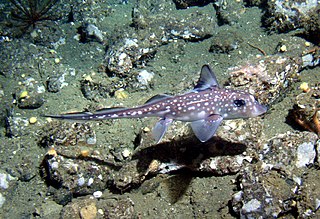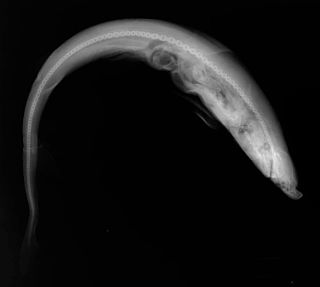
Tetraodontiformes, also known as the Plectognathi, is an order of ray-finned fishes which includes the pufferfishes and related taxa. This order has been classified as a suborder of the order Perciformes, although recent studies have found that it, as the Tetraodontoidei, is a sister taxon to the anglerfish order Lophiiformes, called Lophiodei, and have placed both taxa within the Acanthuriformes. The Tetraodontiformes are represented by 10 extant families and at around 430 species overall. The majority of the species within this order are marine but a few may be found in freshwater. They are found throughout the world.

The Lamniformes are an order of sharks commonly known as mackerel sharks. It includes some of the most familiar species of sharks, such as the great white as well as less familiar ones, such as the goblin shark and megamouth shark.

Arowanas are freshwater bony fish of the subfamily Osteoglossinae, also known as bony tongues. In this family of fish, the head is bony and the elongated body is covered by large, heavy scales, with a mosaic pattern of canals. The dorsal and anal fins have soft rays and are long based, while the pectoral and ventral fins are small. The name "bonytongues" is derived from a toothed bone on the floor of the mouth, the "tongue", equipped with teeth that bite against teeth on the roof of the mouth. The arowana is a facultative air breather and can obtain oxygen from air by sucking it into its swim bladder, which is lined with capillaries like lung tissue.

Chimaeras are cartilaginous fish in the order Chimaeriformes, known informally as ghost sharks, rat fish, spookfish, or rabbit fish; the last three names are not to be confused with rattails, Opisthoproctidae, or Siganidae, respectively.

Fangtooths are beryciform fish of the family Anoplogastridae that live in the deep sea. The name is from the Greek anoplo, meaning "unarmed", and γαστήρ, meaning "stomach". With a worldwide distribution in tropical and cold-temperate waters, the family contains only two very similar species in one genus, with no known close relatives.

The Lamnidae are the family of mackerel sharks known as white sharks. They are large, fast-swimming predatory fish found in oceans worldwide, though they prefer environments with colder water. The name of the family is formed from the Greek word lamna, which means "fish of prey", and was derived from the Greek legendary creature, the Lamia.

Epinephelus is a genus of marine ray-finned fish, groupers from the subfamily Epinephelinae, part of the family Serranidae, which also includes the anthias and sea basses. They are predatory fish, largely associated with reefs and are found in tropical and subtropical seas throughout the world. They are important target species for fisheries.

Citharichthys is a genus of flatfish in the large-tooth flounder family, Paralichthyidae. They have both eyes on the left sides of their heads. They are native to the oceans around the Americas, with a single species, C. stampflii off the West African coast. Most are found in relatively shallow depths, but the genus also includes species found in deep water and species that enter fresh water.

The bigeye sand tiger is an extremely rare species of mackerel shark in the family Odontaspididae, with a possible worldwide distribution. A large, bulky species reaching at least 3.6 m (12 ft) in length, the bigeye sand tiger has a long bulbous snout, large orange eyes without nictitating membranes, and a capacious mouth with the narrow teeth prominently exposed. It can be distinguished from the similar smalltooth sand tiger by its teeth, which have only one lateral cusplet on each side, and by its uniformly dark brown color.
The weasel sharks are a family, the Hemigaleidae, of ground sharks found from the eastern Atlantic Ocean to the continental Indo-Pacific. They are found in shallow coastal waters to a depth of 100 m (330 ft).

Edaphodon was a fish genus of the family Callorhinchidae. As a member of the Chimaeriformes, Edaphodon was a type of rabbitfish, a cartilaginous fish related to sharks and rays. The genus appeared in the Aptian age of the Lower Cretaceous and vanished in the Pliocene. It was most prominent during the Late Cretaceous. Many Edaphodon species were found in the Northern Hemisphere, but species from the Southern Hemisphere are also known.

The Lake Tanganyika sardine is a species of freshwater ray-finned fish in the family Dorosomatidae which was endemic to Lake Tanganyika but which has now been introduced to other lakes in Africa as a food source. It is one of two species within the genus Limnothrissa, the other being the Lake Mweru endemic, L. strappersi. This species and the Lake Tanganyika sprat are known collectively as kapenta.

Ctenochaetus, or bristletooth tangs, is a genus of marine ray-finned fish belonging to the family Acanthuridae, which includes the surgeonfishes, unicornfishes and tangs. These fishes are found in the Indo-Pacific region. They have many, small flexible teeth and some species have the common name bristletooth.

The toothed seadevil, spiny seadevil or netbeard seadevil,, is a rarely seen deep-sea anglerfish found in the mesopelagic and bathypelagic zones in Oceans around the World. It is the only species in the family Neoceratidae, and is unique amongst the deep-sea anglerfish in lacking an illicium and esca, and in having large teeth placed on the outside of its jaws.

Paragaleus is a genus of weasel shark in the family Hemigaleidae. This genus has a rounded or slightly pointed snout, short gill slits, and a broadly arched mouth. The upper teeth have long cusps, and no toothless spaces occur at the jaw midlines. The dorsal and pelvic fins and the lower caudal lobe are not falchate in shape. Known fossil species include P. pulchellus and P. antunesi.

An anchovy is a small, common forage fish of the family Engraulidae. Most species are found in marine waters, but several will enter brackish water, and some in South America are restricted to fresh water.

The grey gurnard is a species of ray-finned fish from the family Triglidae, the gurnards and sea robins. It is native to the eastern Atlantic Ocean, the Mediterranean Sea, and the Black Sea. It is caught as a food fish and is known for producing sounds. It is the only member of the monotypic genus Eutrigla.

Bobasatraniiformes is an extinct order of durophagous ray-finned fish that existed from the late Permian to the Middle Triassic in both marine and freshwater environments. The order includes two families: Bobasatraniidae, with the genera Bobasatrania, Ebenaqua, and Ecrinesomus, and Dorypteridae, comprising only the genus Dorypterus (monotypy). Bobasatraniiformes had a somewhat global distribution; fossils are found in Africa (Madagascar), Asia (Pakistan), Australia, Europe, and North America.

The chiseltooth wrasse is a species of marine ray-finned fish, a wrasse from the family Labridae. It is native to the Indian Ocean and the western Pacific Ocean. It is an inhabitant of coral reefs and can be found at depths from 3 to 60 m, though rarely deeper than 40 m (130 ft). This species grows to 30 cm (12 in) in total length. It is of minor importance to local commercial fisheries and can be found in the aquarium trade. P. moluccanus is the only known member of its genus.

Sebastes diploproa, the splitnose rockfish, is a species of marine ray-finned fish belonging to the subfamily Sebastinae, the rockfishes, part of the family Scorpaenidae. It is found in the northeastern Pacific Ocean.


















